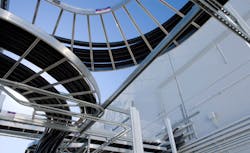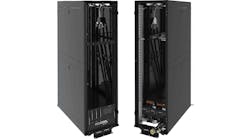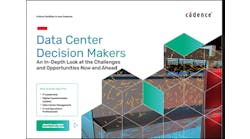The Top 10 Data Center White Papers of 2021: Insights from a Busy Year
2021 was a big year for the data centers. The world continues to shift the way it works and it’s demanding more from our industry. Customers want more power and more speed, and they want those things done sustainably.
To help our readers achieve these goals, Data Center Frontier has presented dozens of white papers and reports from some of the leading companies and thinkers in the industry. The DCF library of data center white papers shared the latest insights on key trends this year including data center sustainability, liquid cooling, site selection, and infrastructure.
Here are the 10 most popular data center white papers of 2021 at Data Center Frontier, ranked by number of reader downloads.
Edge data centers are often a perfect vehicle for supporting AI/ML workloads because they enable high levels of computing power on smaller physical footprints. (Photo: Edgeconnex)
1. The Cloud is Better at the Edge (EdgeConneX)
54% of enterprise IT leaders say digital transformation is their #1 top priority. Cloud is one of the most important tools in the digital transformation processes. But it’s not about the infrastructure, it’s about what the cloud enables: cost efficiency/savings, delivery speed of products and/or services, value delivered to business units, and increased speed of innovation. In short, a good cloud strategy can give you a competitive advantage. The problem is a traditional cloud architecture makes achieving digital transformation challenging. This white paper explains how edge computing helps to solve each of these cloud related digital transformation challenges.
2. Solutions to Data Center Water and Power Availability (Nortek)
The major challenges facing the data center industry today are finite water and power resources. This is especially true for large scale operations and particularly with the ongoing trend toward hyperscale facilities. The data center industry’s exponential growth is predicted to tax the planet’s future water and power supplies. Increased heat loads from new data uses, such as artificial intelligence, Internet of Things (IoT), machine learning, social media and other new technologies will consume significantly more water and power to cool equipment and keep it operating reliably. This white paper explores a new data center cooling method called the StatePoint Liquid Cooling (SPLC)4 system from Nortek Solutions.
3. Five Things To Know About Data Center Site Selection (Stack Infrastructure)
Data center site selection needs to take into account a wide variety of factors, not all of which are intuitive. A data center is a long-term investment, and choosing a location requires being sensitive both to the needs of the business and the surrounding community. When selecting a data center site for a hyperscale facility, obey the five rules of the road outlined in this special report to keep your business and the surrounding community in perfect harmony.
4. Green Data Centers Special Report (Iron Mountain Data Centers)
The urgent need for climate action is writ large in the headlines of 2020. Devastating wildfires have ravaged California, Oregon and Colorado, while a historic series of powerful hurricanes slammed the Gulf Coast. These disasters have been a tipping point in public awareness, driving home the fact that a changed climate is not a future threat, but a current reality. Customers and stakeholders are demanding accountability on climate impact, pushing sustainability near the top of the agenda in selecting sites and providers. In this special report from Iron Mountain Data Centers and Data Center Frontier, we examine the role of green data centers as a catalyst for action on climate change, specific strategies that are reducing carbon impact, and the best ways to embrace the sustainability imperative going forward.
5. Understanding the Importance of Power Quality in the Data Center (Powerside)
While extensive time, money and effort go into the design, installation, operation, and maintenance of the data center, there exists a critical but invisible risk in many data centers’ power chain—the lack of monitoring of power quality. Clean uninterruptible conditioned power is one of a data center’s most critical elements and it can have the most immediate impact if any issues occur. This special report examines the equipment, operational characteristics and conditions that can influence various points in the data center power chain, which ultimately can the impact the power quality and operation of the IT equipment.
6. The Rise of the Sustainable Data Center (Vertiv)
Sustainability is now a top-of-mind issue in data center construction and management, as cloud computing and digital transformation fuel the world’s growing thirst for processing power. And workloads are only going to grow more. A profusion of GPUs and CPUs are being deployed to support a burgeoning number of artificial intelligence applications. Smart devices equipped with 5G wireless networks will give rise to smaller but numerous edge data centers. This report from Vertiv explores the future of the sustainable data center and its impact on the industry.
Many challenges facing integrated liquid cooling architectures are being put to rest with innovative approaches to all-in-one liquid cooling solutions. (Source: Rich Miller)
7. The State of Data Center Cooling (TMGCore)
Data center cooling is rapidly evolving as the adoption of liquid cooling allows the industry to redefine density and support next-generation computing capabilities. As data volume and computing power increases, data centers need to optimize their cooling solutions to keep up with customer demands. Today’s liquid cooling is more efficient and it allows for higher rack densities, both of which make these systems more cost effective than air-cooling. These are just two one of the primary factors driving the adoption of liquid cooling systems. In this special report, we’ll look at the state of data center cooling and how liquid cooling technologies are impacting data center design.
8. 2021 Data Center and Infrastructure Report (Service Express)
Responding to new challenges and preparing for what’s around the corner while protecting and improving the performance of data centers and infrastructure is a constant for IT teams. 2021 plans and projections are still being shaped by the far-reaching effects of the COVID-19 pandemic. Overall, IT has found new avenues to keep organizations operational and growing with resources and agility. How can IT teams best strategize for the 2021 data center and beyond? This report highlights the responses and data garnered from 500 IT professionals in the US to to provide helpful insight into how the industry is taking action today and planning for the future.
9. A New Era of Sustainable Data Centers (NTT/Raging Wire)
The energy footprint taken up by data centers will certainly increase as our reliance on artificial intelligence, machine learning, Internet of Things and 5G grows. Another factor driving even more data use is that the world’s population will continue to increase, necessitating more devices, connectivity, etc. But there is only so much that our planet can take. Fortunately, data centers have the space, technology, and expert staff to evolve in ways that meet the power demands of today and tomorrow without contributing to destructive climate change. This paper discusses what power providers are currently offering in key data center markets, what data centers are doing to be as efficient as possible, and how data center customers can support sustainability.
10. Application of EPA Diesel Tier 4 Final Certified & Compliant Generators (Kohler)
The EPA mandates that all stationary nonemergency generators meet Tier 4 emissions levels. This white paper explains the differences between systems that are compliant through aftertreatment devices, and those that are factory-certified. It also provides guidance on how organizations like data centers can select the best solution for their specific situation. In addition to factory-certification, third-party options like selective catalytic reduction (SCR) systems, particulate filters, and low-NOx engine calibration are covered in the report.
Keep pace with the fact-moving world of data centers by following us on Twitter and Facebook, connecting with Data Center Frontier editor Rich Miller on LinkedIn, and signing up for our weekly newsletter using the form below.

Kathy Hitchens
Kathy Hitchens has been writing professionally for more than 30 years. She focuses on the renewable energy, electric vehicle, utility, data center, and financial services sectors. Kathy has a BFA from the University of Arizona and a MBA from the University of Denver.





